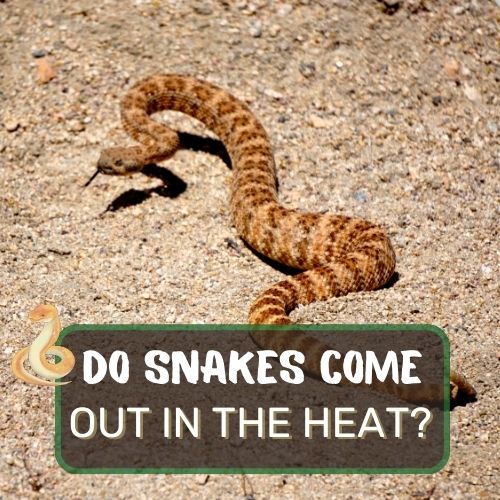
Intrigued by the question “Do snakes come out in the heat”?
Our engaging article unravels the mesmerizing world of snake behavior in warm weather. Explore the factors that influence their activity levels during hotter temperatures and discover why they seek the sun’s warmth.
Uncover the myths and misconceptions surrounding snakes in warm climates and gain insights into their fascinating adaptations to survive in both heat and cold.
Learn valuable safety tips to coexist responsibly with these captivating reptiles.
Whether you’re a snake enthusiast or seeking accurate information, this article provides a comprehensive and human-like perspective on snakes’ behavior in the heat.
Delve into their mesmerizing world and appreciate the delicate balance they bring to our ecosystem.
Table of Contents
- 1 Yes, snakes do come out in the heat.
- 2 Snakes’ Behavior in Warm Weather
- 3 Factors Influencing Snake Activity in Heat
- 4 Snakes’ Preference for Heat or Cold
- 5 Snakes’ Attraction to Heat Sources
- 6 Snakes’ Activity During Cold Weather
- 7 Safety Precautions During Snake Encounters in Heat
- 8 Common Misconceptions About Snake Behavior in Warm Conditions
- 9 FAQ
- 10 Conclusion
Yes, snakes do come out in the heat.
As ectothermic creatures, their body temperature is regulated by the surrounding environment. When the weather is warm, snakes become more active and seek out sunny areas to bask and absorb heat, which helps them maintain their preferred body temperature range.
The heat also increases their metabolism, making them more agile and alert for hunting opportunities. However, during extremely hot temperatures, snakes may retreat to cooler and shaded spots to avoid overheating.
Overall, warm weather encourages snakes to be more active and engage in various activities essential for their survival.
Snakes’ Behavior in Warm Weather

Snakes Coming Out of Hiding During Warm Summer Months
When the sun starts to sizzle, and the summer months roll in, you might wonder if snakes become more active.
The truth is, yes, they do!
Snakes are ectothermic creatures, which means their body temperature fluctuates with the surrounding environment.
As the heat rises, so does their metabolic rate, prompting them to leave their cool hiding spots to bask in the warmth.
Basking in the Heat for Digestion and Energy
Imagine yourself lounging under the warm sun, absorbing its rejuvenating energy. Snakes do the same, albeit for different reasons.
Basking in the sun helps them kickstart their metabolism and aids in digestion. It’s like their version of a power snack that enables them to stay active and maintain optimal bodily functions.
Increased Activity and Hunting During Warmer Temperatures
With the rising heat, snakes become more agile and alert. Increased activity leads to more opportunities for hunting. Prey animals also become more active in warm weather, making it an ideal time for snakes to seek their next meal.
As the temperature soars, these cold-blooded hunters take advantage of the favorable conditions to secure their sustenance.
Factors Influencing Snake Activity in Heat

Impact of Temperature on Snake Behavior
Temperature plays a crucial role in determining snake behavior. As ectothermic creatures, snakes rely on their surroundings to regulate their body temperature.
When it’s hot, they become more active, seeking out warmer areas to maintain their preferred body temperature range.
Conversely, during scorching heat waves, they may retreat to cooler and shadier spots to avoid overheating.
Relationship Between Snakes and Sunlight
The sun is not just a source of warmth; it also impacts snakes’ daily routines. Sunlight acts as a crucial cue for them, influencing their circadian rhythm and behavior.
As the sun rises, snakes may start their day, becoming more active and engaging in essential activities like hunting and mating.
The amount of sunlight they receive can also influence their reproductive cycles.
Influence of Weather Conditions on Snake Movement
Snakes are incredibly sensitive to changes in weather conditions. In areas where the weather is hot and dry, snakes may be more active during the cooler hours of the day to avoid dehydration.
On the other hand, in regions with more humid climates, they might adjust their activity patterns to make the most of the relatively more tolerable conditions.
By understanding these factors that influence snake activity in the heat, we gain valuable insights into the intriguing world of these captivating reptiles.
Next time you ponder about snakes and the scorching sun, remember that they, too, have their ways of embracing the heat while navigating the wild landscape they call home.
Snakes’ Preference for Heat or Cold

Snakes’ Preference for Warmer Temperatures for Hunting and Digestion
Snakes, being cold-blooded, have a clear preference for warmer temperatures when it comes to their daily activities.
The higher the temperature, the more active and energetic they become.
As mentioned earlier, warm weather allows them to digest their meals more efficiently, giving them the energy they need for essential tasks like hunting and reproduction.
In colder temperatures, their metabolism slows down, leading to reduced activity and a more sedentary lifestyle.
Adaptations to Survive in Both Heat and Cold
While snakes favor warmer conditions, they are remarkably adaptable creatures that can endure colder environments as well.
When winter sets in, and temperatures drop significantly, some species of snakes enter a state of hibernation, known as brumation.
During this period, their metabolic rate slows down drastically, and they seek out sheltered locations to conserve energy. This remarkable adaptation helps them survive the harsh winter months until warmer weather returns.
Comparison of Snake Behavior in Different Temperature Ranges
The behavioral contrast between snakes in warm and cold weather is quite intriguing. In the heat, snakes are more likely to be out and about, actively searching for prey and basking in the sun.
On the other hand, in colder conditions, they become less active and tend to remain hidden or sheltered to conserve energy. This dichotomy in their behavior showcases their impressive ability to adjust their activity levels based on the prevailing temperature.
Snakes’ Attraction to Heat Sources
Snakes’ Ability to Detect Heat and Thermoregulate
One of the most remarkable features of snakes is their ability to detect and respond to heat. They possess specialized heat-sensing organs called pit organs, located on each side of their head.
These pits allow them to perceive infrared radiation, which helps them detect warm-blooded prey and navigate their surroundings effectively.
Furthermore, snakes engage in thermoregulation, a process where they regulate their body temperature by moving between warm and cool areas.
Attraction to Heat Sources Such as Rocks, Pavement, and Buildings
Snakes are often drawn to heat-retaining surfaces like rocks, pavement, and even buildings.
These surfaces absorb and radiate heat, making them perfect spots for snakes to bask and regulate their body temperature.
During the cooler hours of the day or in colder seasons, you might find snakes coiled up near such heat sources, soaking in the warmth they provide.
Risks of Encountering Snakes Near Heat Sources
While it’s fascinating to witness snakes utilizing heat sources, it’s essential to exercise caution when encountering them.
Some species of snakes are venomous and can pose a threat to humans and pets. Therefore, it’s crucial to maintain a safe distance and avoid disturbing them.
If you live in an area known for snake activity, take precautions like clearing debris and keeping lawns tidy to reduce potential hiding spots.
Snakes’ Activity During Cold Weather

Snake Behavior During Colder Seasons and Hibernation
As the temperature drops and winter approaches, snake behavior undergoes significant changes. In colder seasons, snakes become less active, and their metabolism slows down considerably.
Instead of seeking out food and basking in the sun, they focus on conserving energy to survive the harsh conditions.
Many snake species exhibit a behavior known as hibernation or brumation, where they retreat to burrows, crevices, or other sheltered spots to wait out the cold.
During hibernation, snakes enter a state of reduced activity, and their bodily functions slow down to a minimum.
They become less responsive to external stimuli and can go for extended periods without eating. Once warmer temperatures return, they emerge from their hibernacula, revitalized and ready to resume their normal activities.
Factors Affecting Snake Activity in Cold Temperatures
Several factors influence snake activity during cold weather. The primary factor is temperature.
As ectothermic animals, snakes rely on external heat sources to regulate their body temperature.
When the environment becomes too cold, their bodily functions slow down, limiting their movement and hunting abilities.
Additionally, the availability of food plays a crucial role. With colder temperatures, many of their prey species may also reduce their activity or go into hibernation.
As a result, snakes have fewer opportunities to hunt and find sustenance during the winter months.
Relationship Between Snakes and Temperature Fluctuations
Snakes have evolved to be highly adaptable to temperature fluctuations.
Their behavior changes based on the surrounding climate, ensuring their survival in diverse environments.
When temperatures rise, they become more active and take advantage of the abundant resources.
Conversely, during colder periods, they rely on their ability to hibernate and conserve energy until the conditions become more favorable for their activities.
Understanding how snakes respond to temperature changes is essential for appreciating their role in the ecosystem.
Their ability to adapt to different conditions reflects their resilience as a species, allowing them to thrive in various habitats around the world.
Safety Precautions During Snake Encounters in Heat

Tips for Avoiding Snake Encounters in Warm Weather
Encountering a snake in the wild can be a thrilling experience, but it’s crucial to remember that some species are venomous and can pose a risk to human health. To avoid snake encounters in warm weather, follow these tips:
- Stay on designated paths and trails: Stick to well-trodden paths when hiking or exploring nature to reduce the chances of stumbling upon a snake.
- Wear appropriate footwear: When venturing into snake-prone areas, wear closed-toe shoes or boots to protect your feet.
- Avoid tall grass and brush: Snakes may hide in tall grass and bushes, so be cautious when walking through such areas.
Proper Snake Identification and Response
If you do encounter a snake, it’s essential to identify the species from a safe distance. Avoid getting too close or attempting to handle the snake, as this can be dangerous.
Remember that many non-venomous snakes mimic the appearance of venomous species for protection.
If you’re unsure about the snake’s identity or suspect it may be venomous, it’s best to retreat slowly and give the snake space.
Most snake bites occur when people try to handle or kill the snake. Respect their space, and they will likely move away from you.
Safety Measures for Outdoor Activities in Snake-Prone Areas
If you live or plan to visit an area known for high snake activity, take additional precautions:
- Keep your yard tidy: Remove debris, woodpiles, and tall grass from around your home to reduce potential snake hiding spots.
- Use snake-proof fencing: If you have concerns about snakes entering your property, consider installing snake-proof fencing around sensitive areas.
- Educate yourself and others: Learn about the types of snakes in your region and educate family members and friends about snake safety.
By following these safety measures, you can coexist with snakes and enjoy the great outdoors responsibly.
Remember that snakes play an essential role in maintaining the ecological balance and deserve our respect and protection.
Common Misconceptions About Snake Behavior in Warm Conditions

Here’s a list of common misconceptions about snake behavior in warm conditions:
- All Snakes are More Active in Heat: While many snake species are more active in warmer temperatures, not all snakes prefer extreme heat. Some species might seek shade or burrow to avoid the midday sun.
- Snakes are Aggressive in Warm Weather: The warmth can increase a snake’s activity level, but it doesn’t necessarily make them more aggressive. They might be more visible as they search for food or mates, but they typically avoid confrontations unless threatened.
- Snakes Always Sunbathe Openly: While snakes do bask in the sun to regulate their body temperature, many prefer dappled sunlight or partially shaded areas to prevent overheating.
- Warmth Attracts Snakes to Human Habitats: Snakes don’t seek out human habitats because of warmth alone. They might be attracted to areas where food (like rodents) is abundant or where there’s suitable shelter.
- All Snakes Hibernate in Winter and Emerge in Warm Months: While many snakes in temperate regions brumate (a form of hibernation) during colder months, not all species do. Some snakes in warmer climates remain active year-round.
- Snakes are More Venomous in Warm Weather: The potency of a snake’s venom is not determined by the temperature. However, snakes might be more active in warm conditions, leading to increased encounters.
- Warm Weather Increases Snake Reproduction: While warmer months can be a breeding season for some species, it’s not universally true for all snakes. Reproductive cycles vary depending on the species and region.
- Snakes Seek Warmth Inside Homes During Hot Days: While snakes might occasionally enter homes, it’s usually in search of food, water, or shelter, not specifically to escape the heat.
- All Snakes Swim in Warm Weather: While many snakes are capable swimmers and might be found in water during warmer months, not all species are inclined to swim.
- Warmth Makes Snakes Faster: While snakes are ectothermic and rely on external heat sources to regulate their body temperature, it doesn’t mean they become super-fast in warm conditions. They might be more active, but their speed varies based on species and individual capabilities.
Understanding snake behavior and dispelling these misconceptions can help in promoting coexistence and reducing unnecessary fear.
FAQ
What Temperature is Too Hot for Snakes?
Snakes are highly adaptable to various temperatures, but extreme heat can be challenging for them. When temperatures exceed 95°F (35°C), snakes may seek shade and shelter to avoid overheating. If the temperature becomes too extreme, they may become less active and may not come out of hiding until it cools down.
What is the Best Time of Day to Avoid Snakes?
Snakes are ectothermic, so their activity levels are influenced by temperature. They are often more active during the early morning and late afternoon when the temperature is moderate. To avoid encounters with snakes, it’s best to be cautious during these times and stay on well-trodden paths.
Do Snakes React to Light?
Yes, snakes can react to light, but not in the same way humans do. They do not have eyelids, so they cannot close their eyes to block out light. However, their pupils can adjust to varying light conditions to help them with vision and hunting.
Can Snakes Taste Heat?
While snakes don’t taste heat in the way humans taste food, they have specialized pit organs that can detect infrared radiation given off by warm-blooded animals. This helps them locate potential prey even in the dark or when concealed by vegetation.
By understanding these frequently asked questions about snakes, we can foster a deeper appreciation for these remarkable creatures and promote a safer coexistence with them in their natural habitats
Conclusion
Recap of Key Points Discussed in the Article
In this comprehensive exploration of “Do snakes come out in the heat,” we’ve delved into the captivating world of snakes and their behavior in warm weather.
We learned that snakes are ectothermic creatures, and their activity levels are influenced by temperature fluctuations.
In the heat, they become more active, basking in the sun for energy and engaging in increased hunting. During colder seasons, many species hibernate to conserve energy.
We also addressed common misconceptions about snake behavior in warm weather, emphasizing the importance of accurate information and education.
It’s essential to respect snakes and their habitats while appreciating their vital ecological roles.
Final Thoughts and Closing Remarks
As we conclude our journey into the intriguing world of snakes, let us marvel at the wonders of nature and the delicate balance that exists in our ecosystem.
Snakes, with their unique behaviors and adaptations, play a vital role in maintaining this balance.
By respecting their space and seeking accurate information, we can foster a harmonious relationship with snakes and contribute to the preservation of these fascinating reptiles for generations to come.
So, the next time you encounter a snake basking in the sun or seeking refuge from the cold, remember the beauty and importance of their presence in our natural world.
Snake Behavior in warm conditions
Discover the Enigma: Do snakes come out in the heat? Unravel their intriguing behavior in warm weather.




0 Comments